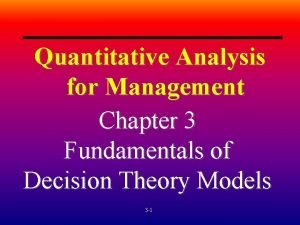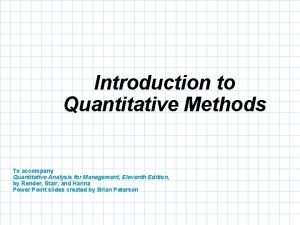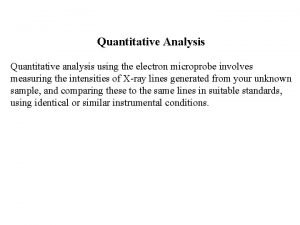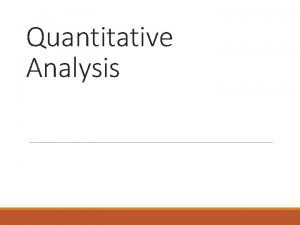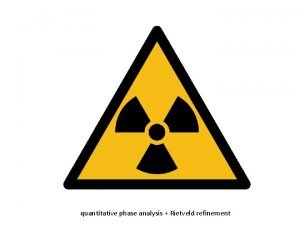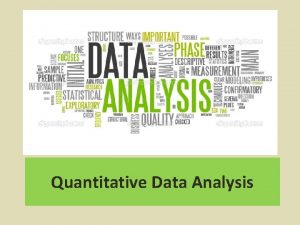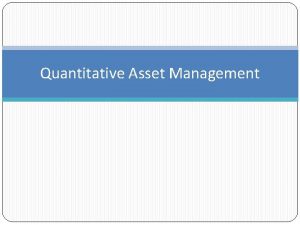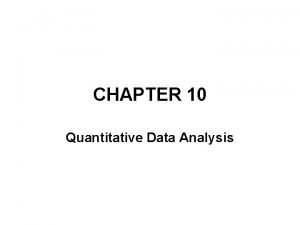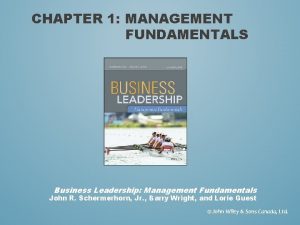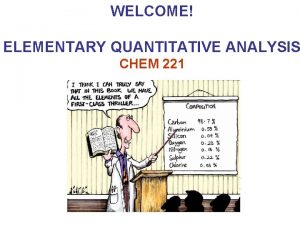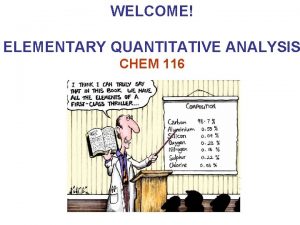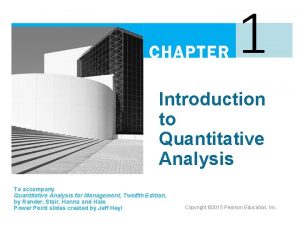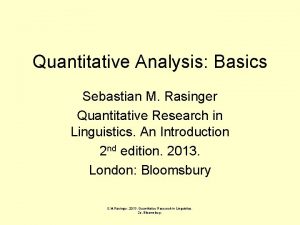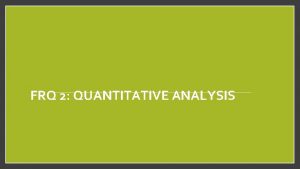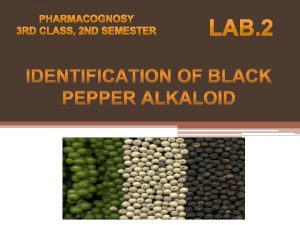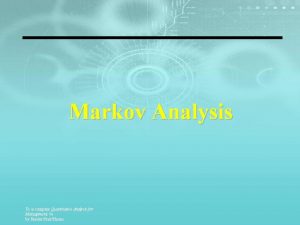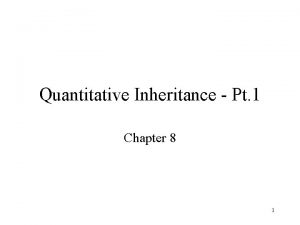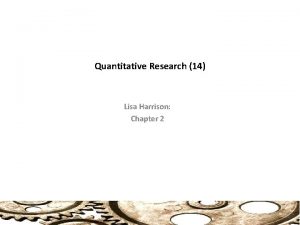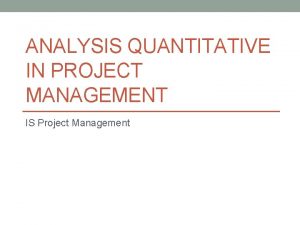Quantitative Analysis for Management Chapter 3 Fundamentals of







































- Slides: 39

Quantitative Analysis for Management Chapter 3 Fundamentals of Decision Theory Models 3 -1

Chapter Outline 3. 1 Introduction 3. 2 The Six Steps in Decision Theory 3. 3 Types of Decision-Making Environments 3. 4 Decision Making Under Risk 3. 5 Decision Making Under Uncertainty 3. 6 Marginal Analysis with a Large Number of Alternatives and States of Nature 3 -2

Learning Objectives Students will be able to: § List the steps of the decision-making process § Describe the types of decision-making environments § Use probability values to make decisions under risk § Make decisions under uncertainty where there is risk but probability values are not known § Use computers to solve basic decisionmaking problems 3 -3

Introduction ¨ Decision theory is an analytical and systematic way to tackle problems ¨ A good decision is based on logic. 3 -4

The Six Steps in Decision Theory ¨ Clearly define the problem at hand ¨ List the possible alternatives ¨ Identify the possible outcomes ¨ List the payoff or profit of each combination of alternatives and outcomes ¨ Select one of the mathematical decision theory models ¨ Apply the model and make your decision 3 -5

Decision Table for Thompson Lumber Favorable Unfavorable Market ($) Construct a large plant Construct a small plant Do nothing 200, 000 -180, 000 100, 000 -20, 000 0 0 3 -6

Types of Decision-Making Environments ¨ Type 1: Decision-making under certainty § decision-maker knows with certainty the consequences of every alternative or decision choice ¨ Type 2: Decision-making under risk § The decision-maker knows the probabilities of the various outcomes ¨ Decision-making under uncertainty § The decision-maker does not know the probabilities of the various outcomes 3 -7

Decision-Making Under Risk Expected Monetary Value: n EMV(Altern ative i) = å (Payoff * P(S j )) j=1 Sj where j = 1 to the number of states of nature, n 3 -8

Decision Table for Thompson Lumber Favorable Unfavorable Market ($) Construct a large plant Construct a small plant Do nothing EMV 200, 000 -180, 000 100, 000 -20, 000 40, 000 0 0 0. 50 3 -9 0

Expected Value of Perfect Information (EVPI ) ( ¨ EVPI places an upper bound on what one would pay for additional information ¨ EVPI is the expected value with perfect information minus the maximum EMV 3 -10

Expected Value With Perfect Information (EV|PI ) ( n EV | PI = å ( best outcome for state of nature j) * P(S j ) j =1 where j = 1 to the number of states of nature, n 3 -11

Expected Value of Perfect Information ¨ EVPI = EV|PI - maximum EMV 3 -12

Expected Value of Perfect Information Favorable Unfavorable EMV Market ($) Construct a large plant Construct a small plant 200, 000 40, 000 Do nothing 0 0. 50 3 -13

Expected Value of Perfect Information EVPI = expected value with perfect information - max(EMV) EMV = $200, 000*0. 50 + 0*0. 50 - $40, 000 = $60, 000 3 -14

Expected Opportunity Loss ¨ EOL is the cost of not picking the best solution ¨ EOL = Expected Regret We want to maximize EMV or minimize EOL 3 -15

Computing EOL - The Opportunity Loss Table 3 -16

The Opportunity Loss Table continued 3 -17

The Opportunity Loss Table continued 3 -18

Sensitivity Analysis EMV(Large Plant) = $200, 000 P - (1 -P)$180, 000 1 -P EMV(Small Plant) = $100, 000 P - $20, 000(1 -P) 1 -P EMV(Do Nothing) = $0 P + 0(1 -P) 1 -P 3 -19

Sensitivity Analysis - continued EMV t) n a l P l (Smal t) n la P e g r a L ( V EM 3 -20

Decision Making Under Uncertainty ¨ Maximax ¨ Maximin ¨ Equally likely (Laplace) ¨ Criterion of Realism ¨ Minimax 3 -21

Decision Making Under Uncertainty Maximax - Choose the alternative with the maximum output Construct a large plant Construct a small plant Do nothing Favorable Unfavorable Market ($) 200, 000 -180, 000 100, 000 -20, 000 0 0 3 -22

Decision Making Under Uncertainty Maximin - Choose the alternative with the maximum minimum output Construct a large plant Construct a small plant Do nothing Favorable Unfavorable Market ($) 200, 000 -180, 000 100, 000 -20, 000 0 0 3 -23

Decision Making Under Uncertainty Equally likely (Laplace) - Assume all states of nature to be equally likely, choose maximum EMV Construct a large plant Construct a small plant Do nothing Favorable Unfavorable Market ($) EMV 200, 000 -180, 000 100, 000 -20, 000 40, 000 0 0 0. 50 3 -24 0

Decision Making Under Uncertainty Criterion of Realism (Hurwicz): CR = *(row max) + (1 - )*(row min) Construct a large plant Construct a small plant Favorable Unfavorable Market ($) CR 200, 000 -180, 000 124, 000 100, 000 -20, 000 76, 000 0 Do nothing 0. 50 3 -25

Decision Making Under Uncertainty Minimax - choose the alternative with the minimum maximum Opportunity Loss Construct a large plant Construct a small plant Do nothing Favorable Unfavorable Market ($) Max in row 0 180, 000 100, 000 20, 000 100, 000 200, 000 0. 50 3 -26

Marginal Analysis ¨ P = probability that demand is greater than or equal to a given supply ¨ 1 -P = probability that demand will be less than supply ¨ MP = marginal profit ML = marginal loss ¨ Optimal decision rule is: P*MP (1 -P)*ML ¨ or 1 - <#>

Marginal Analysis Discrete Distributions ¨ Steps using Discrete Distributions: § Determine the value for P § Construct a probability table and add a cumulative probability column § Keep ordering inventory as long as the probability of selling at least one additional unit is greater than P 3 -28

Café du Donut Example 3 -29

Café du Donut Example continued ¨ Marginal profit = selling price - cost = $6 - $4 = $2 ¨ Marginal loss = cost ¨ Therefore: ML P ML + MP 4 4 = = = 0. 66 4 +2 6 3 -30

Café du Donut Example continued 3 -31

Marginal Analysis Normal Distribution ¨ = average or mean sales ¨ = standard deviation of sales ¨ MP = marginal profit ¨ ML = Marginal loss 3 -32

Marginal Analysis Discrete Distributions ¨ Steps using Normal Distributions: § Determine the value for P. ML P= ML + MP § Locate P on the normal distribution. For a given area under the curve, we find Z from the standard Normal table. - X § Using Z = we can now solve for X* * 3 -33

Joe’s Newsstand Example A ¨ ML = 4 ¨ MP = 6 ¨ = Average demand = 50 papers per day ¨ = Standard deviation of demand = 10 3 -34

Joe’s Newsstand Example A continued 4 ML = = 0. 40 ¨ Step 1: P = ML+ MP 4 + 6 ¨ Step 2: Look on the Normal table for P = 0. 6 (i. e. , 1 -. 04) Z = 0. 25, and 0. 25 = X - 50 * 10 or: X = 10 * 0. 25 + 50 = 52. 5 or 53 newspapers * 3 -35

Joe’s Newsstand Example A continued 3 -36

Joe’s Newsstand Example B ¨ ML = 8 ¨ MP = 2 ¨ = Average demand = 100 papers per day ¨ = Standard deviation of demand = 10 3 -37

Joe’s Newsstand Example B continued 8 ML = = 0. 80 ¨ Step 1: P = ML+ MP 8 + 2 ¨ Step 2: Z = -0. 84 for an area of 0. 80 and - 0. 84 = X - 1000 * 10 or: X = -8. 4 + 100 = 91. 6 or 92 newspapers * 3 -38

Joe’s Newsstand Example B continued 3 -39
 Quantitative analysis for management chapter 3 answers
Quantitative analysis for management chapter 3 answers Define quantitative analysis
Define quantitative analysis Formuö
Formuö Typiska novell drag
Typiska novell drag Nationell inriktning för artificiell intelligens
Nationell inriktning för artificiell intelligens Ekologiskt fotavtryck
Ekologiskt fotavtryck Shingelfrisyren
Shingelfrisyren En lathund för arbete med kontinuitetshantering
En lathund för arbete med kontinuitetshantering Underlag för särskild löneskatt på pensionskostnader
Underlag för särskild löneskatt på pensionskostnader Tidböcker
Tidböcker A gastrica
A gastrica Vad är densitet
Vad är densitet Datorkunskap för nybörjare
Datorkunskap för nybörjare Boverket ka
Boverket ka Tes debattartikel
Tes debattartikel Magnetsjukhus
Magnetsjukhus Nyckelkompetenser för livslångt lärande
Nyckelkompetenser för livslångt lärande Påbyggnader för flakfordon
Påbyggnader för flakfordon Lufttryck formel
Lufttryck formel Publik sektor
Publik sektor Lyckans minut erik lindorm analys
Lyckans minut erik lindorm analys Presentera för publik crossboss
Presentera för publik crossboss Teckenspråk minoritetsspråk argument
Teckenspråk minoritetsspråk argument Plats för toran ark
Plats för toran ark Klassificeringsstruktur för kommunala verksamheter
Klassificeringsstruktur för kommunala verksamheter Epiteltyper
Epiteltyper Bästa kameran för astrofoto
Bästa kameran för astrofoto Centrum för kunskap och säkerhet
Centrum för kunskap och säkerhet Byggprocessen steg för steg
Byggprocessen steg för steg Bra mat för unga idrottare
Bra mat för unga idrottare Verktyg för automatisering av utbetalningar
Verktyg för automatisering av utbetalningar Rutin för avvikelsehantering
Rutin för avvikelsehantering Smärtskolan kunskap för livet
Smärtskolan kunskap för livet Ministerstyre för och nackdelar
Ministerstyre för och nackdelar Tack för att ni har lyssnat
Tack för att ni har lyssnat Mall för referat
Mall för referat Redogör för vad psykologi är
Redogör för vad psykologi är Stål för stötfångarsystem
Stål för stötfångarsystem Tack för att ni har lyssnat
Tack för att ni har lyssnat Borra hål för knoppar
Borra hål för knoppar
